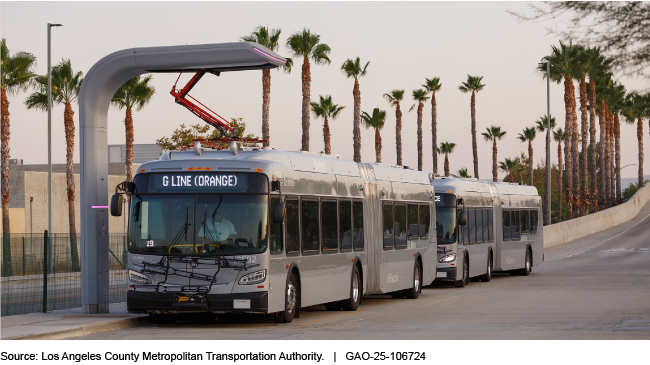Transit Workforce Development: Actions to Support Transition to Zero-Emission Buses
Fast Facts
Greenhouse gas emissions from public transportation can contribute to climate change. These can be reduced by transitioning to zero-emission (e.g., electric) buses. Their use is expected to triple by 2030. But frontline transit workers—drivers and mechanics—will need new skills to service and operate electric buses.
The Federal Transit Administration has taken several steps to help address workforce needs.
For example, the FTA helps transit agencies recruit and train more workers with the technical skills to safely repair and maintain electric buses. It also created a network for transit agencies to share information on apprenticeship programs.

Highlights
What GAO Found
The transit industry is working to address climate change by lowering greenhouse gas emissions, in part by transitioning to zero-emission buses. According to Federal Transit Administration (FTA) data, zero-emission buses comprised 2 percent of the bus fleet for large urban transit agencies nationwide in fiscal year 2022 (2,061 zero-emission buses). FTA projects that zero-emission buses or other vehicles in operation will more than triple by fiscal year 2030 (to 7,700). However, officials from FTA and 10 selected transit agencies GAO interviewed generally agreed that several key challenges need to be addressed in the near term, particularly the limited supply of new zero-emission buses. FTA is working with the industry to address bus supply and manufacturing issues, encouraging actions to reduce bus costs and earlier payments on bus orders.
Transit agency officials GAO met with said that while workforce issues related to the transition are not an immediate priority, they are taking steps to provide training specific to zero-emission buses, as needed, and to address the ongoing shortage of frontline workers. Transitioning to zero-emission buses will most significantly change the traditional mechanic role, making it more of a technician role that requires the use of electronic equipment to diagnose and address engine error codes, according to FTA officials. All 10 selected transit agencies collaborated with bus manufacturers to design training materials and deliver training to their mechanics. However, these transit agencies said their specific future workforce needs are uncertain, in part, because of unpredictable bus delivery timeframes. They said they plan to continue their existing recruitment and retention strategies, such as partnering with community colleges and offering apprenticeships to address current workforce shortages.
FTA is leading several activities to help transit agencies prepare their workforces for zero-emission buses. For example, in 2021, FTA established the Transit Workforce Center to provide direct technical assistance to transit agencies on various workforce issues, including apprenticeships, training, and recruitment.
Battery Electric Buses and Charging Equipment, King County Metro

Why GAO Did This Study
The Infrastructure Investment and Jobs Act made about $5.6 billion available for the Low or No Emission Grant Program for fiscal years 2022 through 2026 to help transit agencies purchase low- and zero-emission buses, and for related purposes. The successful deployment of zero-emission buses—battery electric and hydrogen fuel cell electric buses—depends in part on transit agencies having skilled workers to operate and maintain these buses.
House Report 117-402 includes a provision for GAO to review workforce development needs as transit agencies transition to zero-emission vehicles. This report describes: (1) the status of transit agencies' transition to zero-emission bus fleets and any challenges they may face meeting transition goals; (2) skill- and workforce-development needs of transit agencies and actions selected agencies are taking to address any workforce gaps; and (3) FTA actions to assist transit agencies in preparing their workforces for zero-emission buses.
GAO analyzed FTA data on the nationwide bus fleet as of 2022—the most recent available data—and reviewed applicable statutes, regulations, and agency documents. GAO interviewed 18 transit stakeholders and officials at 10 selected transit agencies to obtain views on zero-emission buses and workforce development needs. GAO selected transit agencies based on factors including agency location and fleet makeup. GAO also interviewed officials at eight transit entities in the Netherlands and United Kingdom about their workforce transitions, as they have high numbers of zero-emission buses in operation.
For more information, contact Andrew Von Ah at (202) 512-2834 or vonaha@gao.gov.
